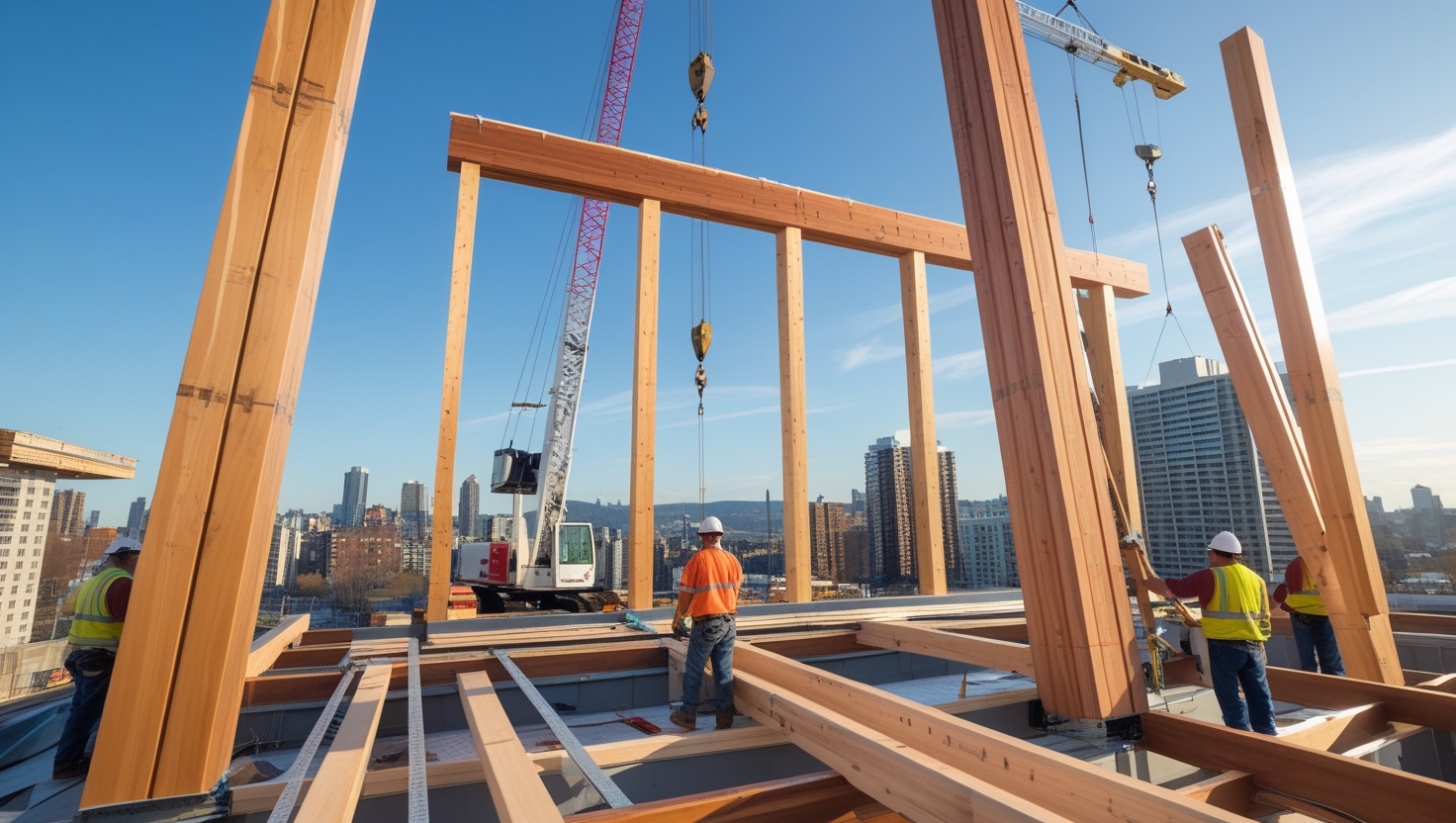When it comes to framing a floor or roof, joists are the silent heroes of structural integrity. As key components in any framework, these long, horizontal members support weight, distribute loads, and provide the essential foundation for decking, insulation, and roofing. Whether you’re building a residential home, a garage, or a commercial facility, understanding joist installation is crucial.
Let’s break down the facts, functions, materials, and engineering decisions behind joists so you can build smarter and safer.
Why Joist Installation Matters
According to the National Association of Home Builders (NAHB), floor joists make up over 60% of the horizontal support in standard wood-frame buildings. Improper installation leads to deflection, floor bounce, and even structural failure. In 2022, the International Code Council (ICC) cited that improper span and placement of joists were among the top 10 framing violations during inspections. In fact, nearly 1 in 5 residential framing inspections found issues related to joist installation.
Installing joists correctly ensures:
Consistent load-bearing support
Balanced framing and decking
Reduced structural stress
Long-term durability of your building
With the average U.S. home requiring over 1,000 linear feet of joists, even small errors can amplify into large problems. joist-related failures are among the most expensive structural issues to repair, with costs sometimes exceeding $10,000 for full subfloor replacements. Homeowners and contractors alike must take every step to get this process right.
It’s also worth noting that joist systems influence energy performance and sound insulation. Poorly installed joists can lead to air gaps, creaky floors, and cold spots, affecting not only structural safety but comfort and efficiency. That’s why understanding joists is a foundation-level skill for every builder.
An additional factor to consider is fire resistance. While most residential joists are made from wood, many builders are turning to fire-rated options or applying intumescent coatings to improve safety. For example, I-joists with factory-applied fire resistance can delay the spread of fire and protect structural integrity long enough for occupants to exit and firefighters to respond.
the increasing trend in open-plan living spaces puts extra stress on joists. With fewer interior walls acting as load paths, floor joists must carry more load over wider spans. This demands more thoughtful engineering and often requires the use of double joists or integrated steel flitch plates.
Finally, in multifamily buildings and mixed-use developments, soundproofing is as important as strength. Using insulation between joists, sound-dampening sheathing layers, and resilient channels has become standard to meet residential code requirements and increase occupant satisfaction.
Understanding Joist Functions and Roles
Joists are horizontal members that run parallel and evenly spaced between girders, beams, or load walls. They support:
Subflooring
Roof decking
Ceilings
Mechanical systems
Each joist must carry both dead loads (e.g., weight of the structure) and live loads (e.g., people, furniture, snow). Engineering calculations determine the correct span, spacing, and material based on these loads. Properly spaced and installed joists maintain the structural equilibrium of the entire floor or roof assembly.
In modern carpentry, joist spacing typically follows these configurations:
12 inches on center (residential, high load)
16 inches on center (standard)
24 inches on center (light load)
But spacing is only one part of the equation. Joists must also be supported and aligned with critical bracing and anchoring to ensure rigidity. In high-wind or seismic zones, joist anchoring becomes even more important. Regional codes often mandate hardware reinforcements and anchoring techniques to improve resistance to lateral and uplift forces.
joists are essential to acoustic performance in multistory buildings. Floor systems incorporating insulation between joists or floating floor designs reduce impact and airborne noise, making joist detailing important even beyond structural performance.
Joists also serve an aesthetic and practical role in certain architectural designs. In exposed ceiling applications, joist material, finish, and layout contribute to the overall interior character. Timber joists with visible grain can add warmth and visual rhythm to rustic or industrial interiors.
Choosing the Right Joist Material
The material choice dramatically influences joist performance, cost, and lifespan. There is no one-size-fits-all approach when it comes to joist materials. Project-specific variables such as moisture exposure, span requirements, budget, and local building codes must be weighed carefully.
Solid Sawn Lumber
Most commonly used in traditional homes, dimensional wood like 2×10 or 2×12 is affordable and familiar to builders. However, it is prone to warping and is limited in span.
Max span for 2×10 SPF: approx. 16 feet (under 40 psf live load)
Common species: Douglas fir, Southern yellow pine
Softwoods such as Douglas fir are favored for their strength-to-weight ratio and relative affordability. They are easy to cut, drill, and install, but require careful moisture control and regular inspection to prevent long-term degradation.
Engineered Joists (I-Joists)
According to APA – The Engineered Wood Association, I-Joists account for over 50% of floor systems in new homes.
Longer spans up to 26 feet
High resistance to warping
Integrated knockouts for plumbing and HVAC
Engineered joists offer enhanced predictability and performance. Manufacturers provide detailed span charts and load tables, simplifying engineering decisions. These joists are ideal for open-concept floor plans and large rooms without intermediate walls or columns.
Steel Joists
Used in commercial and industrial buildings, steel offers unparalleled reinforcement and support, though it requires advanced tools and techniques. Steel joists resist fire, pests, and moisture better than wood, making them ideal for harsh environments or buildings requiring extreme durability.
However, installation demands precision and often involves welders or specialized fasteners, adding to the labor cost. Steel joists also require fireproof coatings in many jurisdictions.
Critical Design and Span Calculations
Engineering joist layout starts with calculating the maximum allowable span based on:
Lumber grade and species
Joist size and depth
Load types (live and dead)
For example:
A 2×10 Douglas fir joist, spaced 16 inches on center, can safely span up to 18 feet under residential floor loads (40 psf live, 10 psf dead)
A 14-inch I-Joist can span up to 26 feet
In commercial construction, steel bar joists can span up to 60 feet depending on load and design. These spans reduce the need for intermediate supports, creating more open and flexible floor plans.
Local building codes, such as IRC R502.3, provide tables for design values. It is critical to adhere to these codes during layout and fabrication. Structural engineers often use software tools like ForteWEB or Javelin to optimize joist design based on regional codebooks and real-world conditions like snow load, wind load, and seismic activity.
Framing Best Practices for Joist Installation
Proper joisting techniques ensure structural reliability and efficient load distribution:
Plan Layout: Define load paths and mark joist spacing on headers.
Crown Up: Ensure the natural curve of lumber (crown) faces upward to allow settling under load.
Use Joist Hangers: Metal connectors improve support at beam or ledger junctions.
Block Between Joists: Use cross- or solid blocking every 6-8 feet to prevent twisting.
Avoid Over-Notching: Notching or drilling should follow precise guidelines to preserve engineering strength.
Additional best practices include:
Ensuring end bearing of at least 1.5 inches for wood joists
Using rim joists or band boards to tie the system together
Applying adhesives between subfloor and joists to minimize squeaks
Inspecting all fasteners and hangers before covering with decking or sheathing
Sheathing and Decking Integration
Once joists are installed, sheathing (typically plywood or OSB) is applied. This locks the framework, provides a base for flooring, and adds lateral bracing. For roofs, decking is laid similarly and topped with underlayment and shingles.
Key Considerations:
Use 3/4-inch plywood for floors with joists at 16-inch spacing
Apply subfloor adhesive to minimize movement
Stagger seams for greater structure and stability
In addition to improving load transfer, proper sheathing prevents air infiltration, increases thermal resistance, and enhances sound attenuation. When working in high-humidity areas or unconditioned spaces, opt for tongue-and-groove panels with edge support clips.
Reinforcement and Long-Term Maintenance
For added strength and lifespan:
Install double joists under heavy partitions or tubs
Use columns or girders to break large spans
Inspect for water exposure or rot regularly
Joist systems, especially in basements and crawlspaces, benefit from added reinforcement like bridging or rim boards to prevent lateral displacement. Regular maintenance includes checking for:
Water leaks from above (plumbing, HVAC)
Insect or rodent damage
Signs of sagging or uneven floors
Periodic re-nailing of subfloor sheathing and inspection of fasteners and hangers helps extend the life of the framing system. Modern retrofitting may include steel plates or carbon fiber straps to reinforce aging wooden joists.
Common Installation Mistakes to Avoid
Incorrect span for joist size
Misaligned joist spacing
Ignoring load-bearing direction
Skipping fasteners or improper assembly
Other pitfalls include:
Using incorrect fasteners (e.g., nails where screws are required)
Not accounting for point loads from bathtubs or islands
Failing to adjust for joist cantilevers
Misjudging wood shrinkage or swelling over time
These mistakes not only weaken your architecture but may violate building codes and delay inspection approval. Structural failures linked to joist issues can cause long-term litigation risks and undermine confidence in the build quality.
Final Takeaway
Proper joist installation is more than a step in framing. It is the core of structural performance. From precise measurements and material choice to bracing and sheathing, every decision affects the life and quality of your building.
By following best practices and using factual load data, your joist system will deliver on what it promises: safety, support, and strength from the ground up. Whether you’re a contractor, architect, or dedicated DIYer, investing time in proper joist design and execution pays dividends for decades.










